How Did Your Mom Screw You Up?

“Apter identifies five categories of difficult mother: the angry mother, the controlling mother, the narcissistic mother, the envious mother and the emotionally unavailable mother. She is careful to caution that only around 20 per cent of mothers will fall into these categories — the rest are just normal, flawed humans — but if your parent does fit one of these types, it can have a profound effect on whom you become.”
— Now I know they say “only around 20 per cent,” but let’s be honest, it’s all of them. Which one was yours?
Photo by artproem, via Shutterstock
Angelina Jolie, Martin Amis and Prince William: Where Are They Now?
by Matt Haber
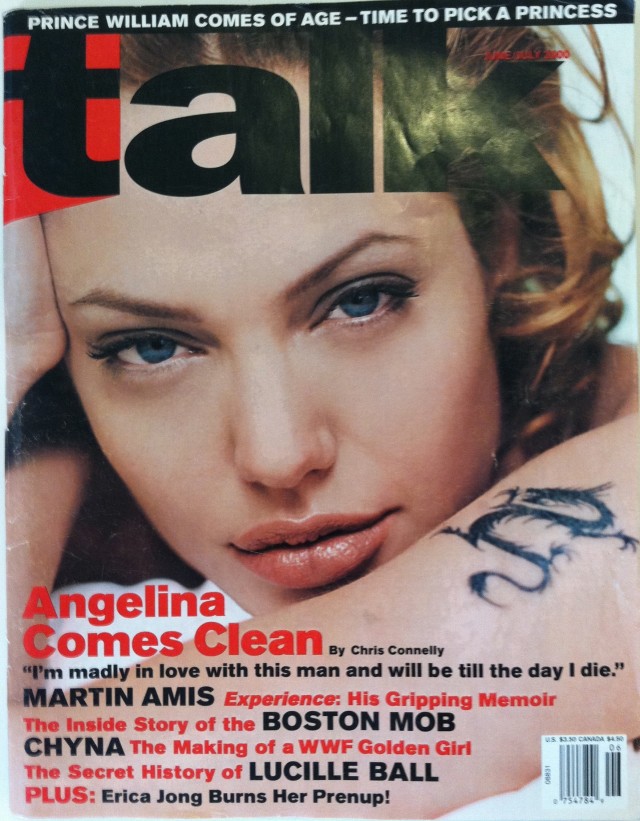
Once upon a time there was a princess who lived in a castle before she ran away and married an ogre. Together they spawned Talk, a magazine sprinkled with synergy dust and celebrated across the land. It was so wonderful, it only lasted two years….
Here are some of the things you’d learn reading the June/July 2000 issue of current Newsweek/Daily Beast honcho Tina Brown’s Talk: Now that he’s 18, Prince William (“’Wills,’ his mother called him”) “needs a bride”; Erica Jong burned her prenup with husband, Ken Burrows; Gigi Levangie Grazer “lives in Pacific Palisades with her second husband, superproducer Brian Grazer”; “Amy Smart has played it like her last name”; Hugh Jackman is “Better-looking than Superman”; “übermodel Heidi Klum got the first film role she ever read for”; Jean Pigozzi “never leaves one of his five houses — or his yacht — without one of his trusty Leicas”; Billy Bob Thornton is “just the sexiest fucking… creature that ever lived” according to Angeline Jolie, and, according to the cover, she will be in love with him “till the day I die”; this is how the “feisty young” partners at Endeavor get along according to Ari Emanuel: “We fight and we fuck”; and Bo Peabody could’ve sold his internet company Tripod to “AOL Yahoo!, Microsoft, Excite — but we went with Lycos. It felt great.”
Let’s go inside.
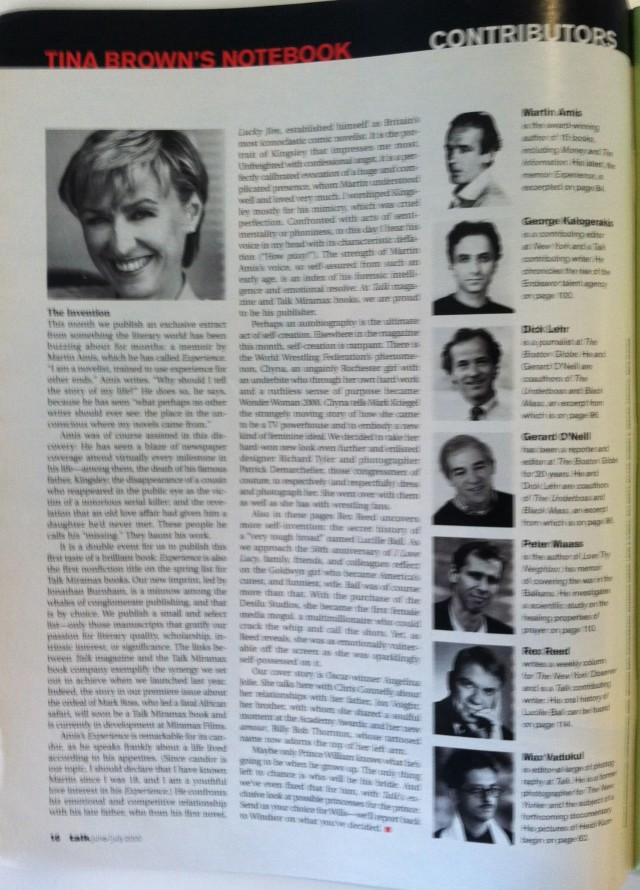
Then…
“This month we publish an exclusive extract from something the literary world has been buzzing about for months: a memoir by Martin Amis, which he has called Experience…. It is a double event for us to publish this first taste of a brilliant book: Experience is also the first nonfiction title of the spring list for Talk Miramax books.” — Tina Brown’s Notebook, June/July 2000.
Now…
“The alluring bad boy of literary England has always been fascinated by Britain’s dustbin empire. Now Martin Amis takes on American excess.” — Sam Tanenhaus, Newsweek/Daily Beast, June 25, 2012.
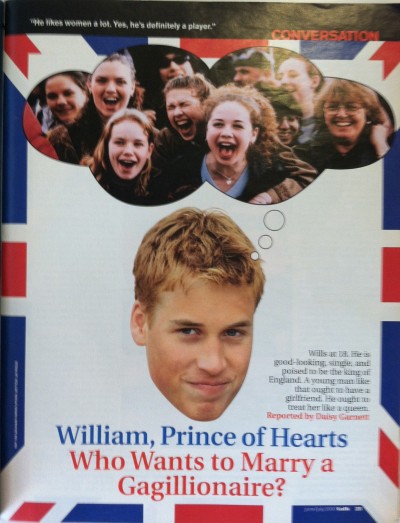
Then…
“Wills is e-pals with Britney Spears. He has a crush on Baby Spice. He was observed not so long ago making out with a 25-year-old woman mutual friends refer to as his ‘cousin,’ Emma Parker Bowles, niece of his father’s longtime consort Camilla. (‘Nothing much came of it,’ says a friend of his. ‘But still, it’s pretty good, to snog a 25-year-old when you’re only 17.’)” — Daisy Garnett, “Who Wants to Marry a Gazillionaire,” which is accompanied by a four-page chart of possible girlfriends, which included the princess of Sweden, Gisele Bündchen, Natalie Portman, Serena Williams, and Jenna Bush.
Now…
“There is a common view today that Prince William hates the press and, given his experiences, it would be surprising if he didn’t.” — Penny Juror, The Daily Beast, June 5, 2012.
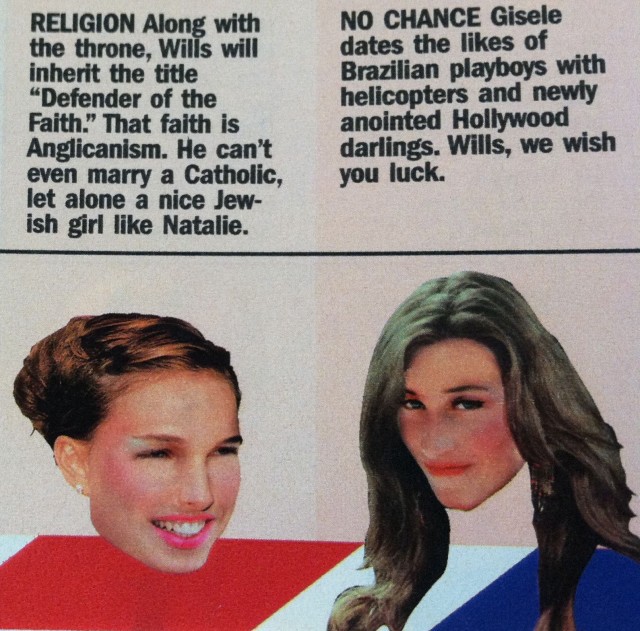
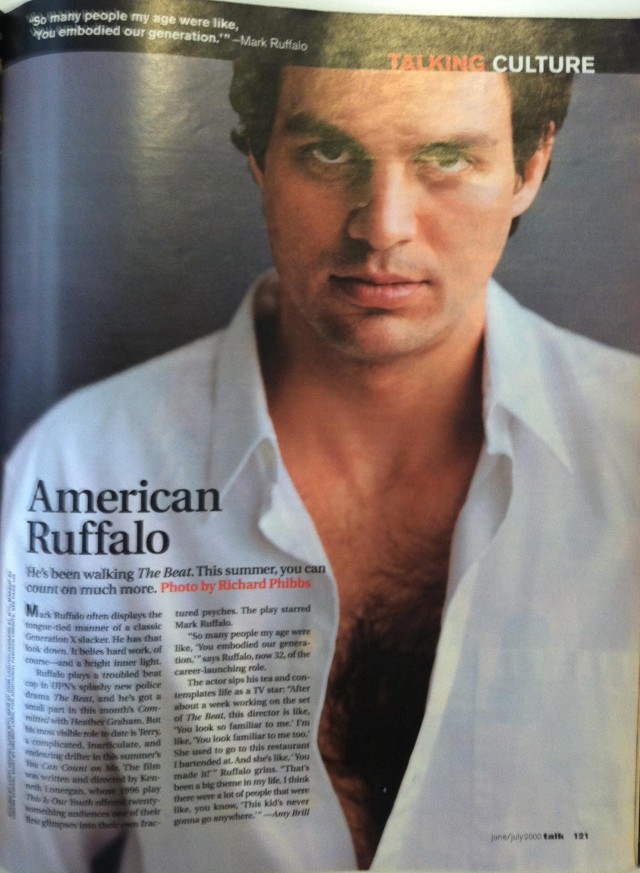
Then…
“The religious aspect of Internet mania has not gone unnoticed; it just hasn’t been taken that seriously. Recently in these pages, Tucker Carlson observed that high-tech capitalism has taken on many of the characteristics of a religious movement: ‘It’s no longer good enough… to become impossibly rich. If you’re a visionary CEO, it’s vital that you make a connection between your own fortunes and enthusiasms and the fate of the entire world.’” — John D. Gartner, “Prophet Or Loss.”
Now…
“In two short decades, the Internet has changed almost everything about the way we live: The way we communicate, the way we shop, the way we read, the way we love, the way we fight, the way we play. So, too, the people shaping and changing the world are a breed apart from the old ruling class. Moguls, Masters of the Universe, military despots… your time has come and gone. The geeks have inherited the earth!” — Newsweek/Daily Beast “Digital Power Index,” June 25, 2012.

The takeaway:
2000 was a long time ago. So long ago, magazines didn’t have URLs on their covers, Angelina Jolie was photographed smoking and drinking a glass of wine and didn’t talk at all about human rights, and the wrestler Chyna got a seven-page profile. It was also a time when a general interest magazine could include an excerpt from Jim Knipfel’s memoir and an as-told-to story by Peter and Bobby Farrelly’s mom, Mariann. Much of the June/July 2000 issue of Talk feels dated (Sean Patrick Thomas from Save the Last Dance is now on a canceled CW show), but some of it, like Dick Lehr’s and Gerard O’Neill’s piece about Whitey Bulger feels surprisingly relevant. The ten-page oral history of Lucille Ball by Rex Reed (supply your own exclamation point) could run in Vanity Fair next month.
For all the criticism Talk got for being a Miramax promotional pamphlet, there’s not a ton of Miramax-centric content besides the Amis excerpt, a photo spread of Heidi Klum in advance of the utterly forgettable (and forgotten) British hairdressing comedy Blow Dry; as far as house ads go, there’s one for Talk Miramax Books’ Bosie: A Biography of Lord Alfred Douglas, Kenneth Branagh’s adaptation of Love’s Labour’s Lost (featuring Alicia Silverstone and Matthew Lillard), and a quarter-page promotion that lets you enter to “Win two tickets to a Miramax Movie Premiere” of Ethan Hawke’s Hamlet. In all, a pretty restrained example of late-90s/early-aughts synergy.
Matt Haber just found a stack of old Talk magazines on Broadway near Canal Street.
Simple Answers To Silly Scientist's Questions About Fairy Circles
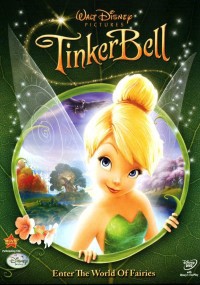
Florida State biologist Walter R. Tschinkel has been studying the millions of 6-to-30-foot-diameter patches of barren earth in Namibia’s grasslands known as “fairy circles.” For some reason, Tschinkel is perplexed. He has some questions:
“Why are they regularly distributed, rather than random or clumped. Why do they appear with the grass dying suddenly; why is there taller grass at the perimeter; and why is there a difference in diameters? … The mystery of the fairy circles, or at least what causes them, remains a mystery.”
What is the “mystery?” There are obvious, well-known, answers to all these questions:
1) Fairy circles are regularly distributed rather than random or clumped because fairies are anal-retentive, obsessive-compulsive neat freaks. As reported on the Psychic Readings With Marie website, “Most house fairy (elves, pixies, brownies) are very fussy about the homes they live in.”
2) Fairy circles appear with the grass dying suddenly because fairies wear boots. Big, heavy, grass-stomping boots.
3) There is taller grass at the perimeter of fairy circles because fairies are shy and value their privacy.
4) There is a difference in the diameter of various fairy circles because some fairies are bigger than other fairies. Standard fairy size is six inches, but if fairies eat asparagus, they grow larger, and if they eat radishes, they shrink.
5) Fairy circles are caused by fairies.
Understanding the Barclays Craziness

LIBOR what? Barclays who? Do you have no idea what’s going on? This helps. Do you want someone to explain what he did in falsely representing the bank? Here you go. Do you wish that a subway stop and a stadium in Brooklyn weren’t named for the bank? Do you find it hilarious that the fines the bank paid for LIBOR manipulation are greater than the amount they promised to the Barclays Center? Oh well, nothing you can do, just be grateful it’s not called Enron Field.
Santigold, "The Keepers"
“In the video for ‘The Keepers,’ which Santi directed herself, she sticks to the lyrical theme of a self-destructive delusional American society…numb, insane, and creepy. The clip has shades of John Waters, David Lynch, and a whole lot of Cindy Sherman (a photographer who has spent the past 35 years taking photos of herself dressed up in various creepy costumes. I actually find her work pretty grotesque, but I respect her cojones). ‘The Keepers’ has everything from glo-worm jello molds, to June Cleaver blond wigs, a GZA cameo, a murdered milkman, and Santi’s signature marionnette dance moves… It’s weird and I love it.”
— The new Santigold video is a thing that Miss Info loves. Me, too.
Racing You Out The Door!
LET’S ALL DO OUR WORK AS FAST AS POSSIBLE AND THEN RUN SCREAMING FROM OUR WORKPLACES.
(iTunes)
An Analysis of the Thomas Kinkade Calendar for July
by Drew Dernavich
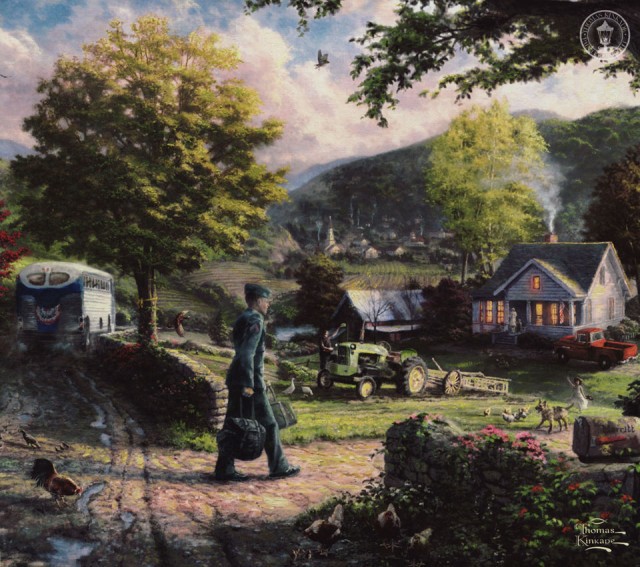
“I have something in common with Norman Rockwell,” Thomas Kinkade once reflected. “I like to make people happy.” Right, and that’s also why Krispy Kreme makes sugary donuts and why Joe Francis makes “Girls Gone Wild” DVDs. Regardless, nobody would argue too much against the fact that Kinkade, the fine art painter, is considered in the same “American populist” category as Rockwell, the magazine illustrator. However, Rockwell also confessed that “I am a story teller.” And this is where the similarities abruptly end between Rockwell and the man who so badly wanted to be mentioned in the same breath as his idol.
The July page in the 2012 “Thomas Kinkade: Painter of Light” calendar is “Homecoming Hero,” a painting which is an attempt to mine the same emotional territory that Rockwell did so successfully. The scene depicts an American soldier stepping off of a patriotically festooned bus and into the large talent gap between the two artists. Check that: on second look, we see that the soldier is only stepping into a Kinkade painting. But this is a panorama, not a story. Stories must have tension and resolution, and in Kinkade there is always only resolution. It would have been more honest to name it Landscape with Soldier, in the manner of the early French landscapists like Claude Lorrain. Or perhaps a nod to Manet: Patriotic Subject Matter on the Grass (). Or, better yet: Cliche Descending a Driveway.
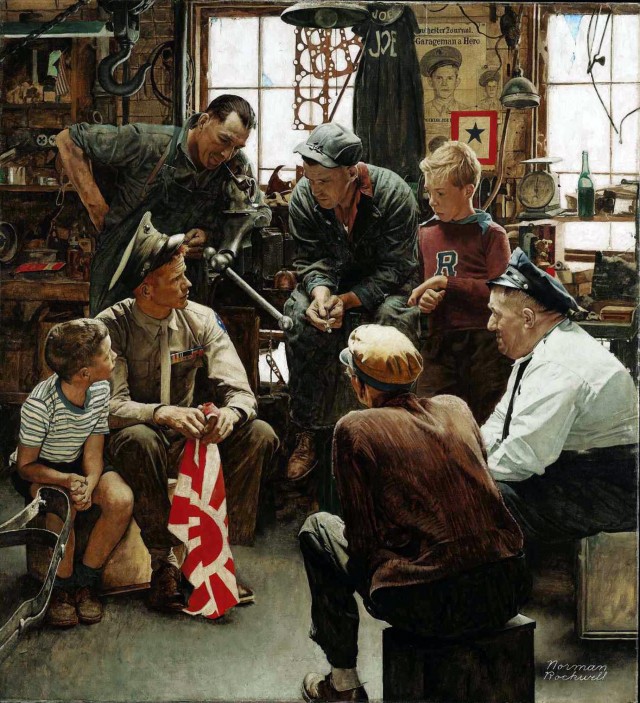
Let’s look at the painting that Kinkade was aiming for when he did this one: Rockwell’s “Homecoming Marine,” from the October 13, 1945, cover of the Saturday Evening Post. It’s one of his best works. First of all, context. This represents a real individual from an actual war, specifically the Japanese theater from WWII. Kinkade has said elsewhere that lack of specificity equals universality. This might be true for another artist. In the land of Kinkadia there is no war, period. There is no conflict, only serenity. What, exactly, is this man returning from?
Now, it does not give automatic credibility to an artist just because he is against war. Protest art can be just as insipid (I’m looking at you, Yoko), and art that is obsessed with revealing ugliness can be just as flimsy as art that is overly concerned with looking beautiful. But Kinkade could not even acknowledge in art what soldiers must face in real life. There is not even a symbol of anything anywhere that might represent one of the darker impulses of mankind, and so the tribute is impotent, even insulting. This soldier might as well be returning from a cotton-candy food fight. Save your war stories — Kinkade doesn’t want to hear them. He just wants to profit from them.
Next, look at the group gathered in Rockwell’s portrayal. They are individuals, and they are connected physically and emotionally. There is drama in the poses, the faces, the clasping of hands. It is not all smiles and relief, and it looks as if the homecoming soldier might even be relating details of horrific events. But he belongs to this group of men, as we can see by his picture posted on the wall.

We are invited into the conversation. By contrast, Kinkade’s people have no discernible expressions and no connections. The family members wave as if they are saying hello to a neighbor passing by. How do you show an intimate reunion among family members when you are reluctant to depict actual individuals? Trite, marketable sentiments will do. There is more intimacy between the shapes in Mondrian’s geometric grids than there is here. Notice how the human faces are inscrutable, but Kinkade has still found the energy to zoom in and scrawl the name “Merritt” on the soldier’s bag with precision. You can tell where the emotional center of a work is by where the artist has chosen to spend his time, and it’s in gimmicks.
But — the detail! The trees and the flowers! The birds in particular stand out, especially the flying turkey that is supposed to be in the background. They are rendered crisply and with more contrast than the humans. The grouse (?) in the street and its chicks seem to have covered more ground than the soldier in the moments since the bus departed. Also, it wouldn’t be a Kinkade without the many chimneys burning those cozy July fires! And this time, it really does look as if the house is ablaze. That is not a cozy, snuggle-up-by-the-fireplace glow. That is a raging inferno ready to consume the entire dwelling. Perhaps this should be titled Homeless Hero. It’s a good thing a trained military man is on hand, because it looks like the battle has just begun.
Previously: January, February, March, April and May and June
Drew Dernavich is a cartoonist for the New Yorker magazine (not that cartoonist — the other one) and the co-creator of the cartoon improv show Fisticuffs! He is on Twitter.
